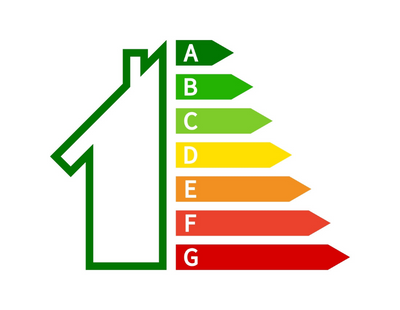The current state of play is that there is a Bill wending its way through Parliament that will make it illegal to rent out a property with an EPC of less than a ‘C’ by 2028.
By 2025 no new tenancy agreements can be taken out on properties with an EPC of less than ‘C’ and that date is not far away.
Given that around 3.2m privately rented properties in England and Wales have an EPC rating of D or below this is quite some undertaking and unsurprisingly there is carrot and stick being used to make it happen.
Without a doubt we can expect tenants to become more interested in the energy efficiency of the homes they rent. Quite apart from being concerned about the environment the current soaring cost of fuel will be a motivating factor. The first step for landlords is to dig out the EPCs for their current properties and see what can be done.
An EPC will show you the current energy rating for your property (on a sliding A to G scale) and what it could achieve if certain listed recommendations were made. We have teamed up with Elmhurst Energy, the largest training provider and accreditation scheme for EPC assessors, and their website provides plenty of useful advice on how to read and act on an EPC.
Sometimes simple adjustments such as more energy efficient lighting and draught excluders will make a difference.
Lenders too are responding to the focus on climate change by launching green-related mortgage products. We have counted the number of these aimed at landlords as increasing threefold in the last six months. So, if you already have energy efficient properties on your books you could be reducing your mortgage costs so it will be worth talking to your lender or broker. We have reprogrammed our algorithms to flag to a customer if there is a green deal that would save them money.
But there is ‘stick’ as well as carrot.
Whilst the ‘C’ requirement will not apply to all tenancies until 2028 we can expect lenders to be asking questions of landlords with low rated properties well before that. The last time the certification was upped, which was then to an ‘E’, we saw lenders build it into their decision-making process well before the deadline. Quite apart from not wanting to lend to properties that can’t be rented beyond a certain date, lenders too are under pressure to ‘green’ their lending portfolios.
What though you may be asking of the properties that will struggle to reach a ‘C’ without a huge amount of expenditure?
At the moment landlords are expected to spend up to a cap of £3,500 to improve energy efficiency but there are already calls for this to be upped to £10,000. My view is that the government know full well the risks they would be running here by putting such a huge increase in costs on the private rented sector.
A housing minister at the Conservative Party conference said only the other day that the government was wary of the “untended consequences” of adding to the burden on landlords. As well they might, particularly now they have had to abandon their planning reforms which would have forced local authorities to give up land for development. Fewer new houses will mean more reliance on the private rented sector which already houses almost one in five households.
The countdown is on for the government to publish its long-delayed and surely imminent Heat and Building Strategy. This should give landlords and indeed all of us some sort of roadmap from how we get to where we are now to where we need to be.
It must surely contain either financial support to make the transition or at the very least a reasonable limit on what can be expected. Landlords should do what they can to make a difference at the moment but if this all resembles a game of grandmother’s footsteps it’s not time to run for the hills yet.
Angus Stewart is chief executive of online buy-to-let mortgage broker Property Master.
Want to comment on this story? If so...if any post is considered to victimise, harass, degrade or intimidate an individual or group of individuals on any basis, then the post may be deleted and the individual immediately banned from posting in future.








.jpeg)







.png)





Join the conversation
Jump to latest comment and add your reply
I hear that houses in conservation areas do not need EPC's. Does anyone know more aboout this?
A reassuring note from Angus but when are people going to wake up and realise that when it comes to conservation measures in HMOs none of them work . I have fitted new boilers and insulation to my HMOs then when I measure the difference in the amount of gas and electricity used it makes no difference. I measured the use of gas and electricity in my over 100 HMOs and I have the stats prove this. Do not get me wrong I would like to save money but the measures they say that work do not work in practice.
Ask any landlord who has had energy conservation measures carried out how much it saved they will usually mumble something to the effect, 'oh yes a good saving'. Ask them did they the measure the amount of gas and electricity that was used before installation and afterwards and they will look at you blankly. How do they know they are saving money? Typical responses are: 'my bills have not gone up', when asked whether their energy bills had gone up they did not know. From their response I was pretty certain their bills had not gone up. The other common response is, ' of course it saves money the publicity says so !'.
But then again should I be surprised nearly every one of the measures the government or Council impose on HMOs in the so called drive to improve quality and safety are not of any benefit when measured on a risk cost basis and often do great harm to the tenants.
Jim Haliburton
The HMO Daddy
I don’t pretend to understand or make sense of what’s going on. There are 25 million Residential Properties in UK and only 3.2 million privately rented, (I do mind been corrected). Then does this mean 21.8 million homes that don’t have to take the same measures are dependent on 3.2 million properties to raise standards so much as to meet UK’s emissions targets on our own, aren’t we fantastic while at the same time provide private Banking for local Authorities.
Gabrielle don’t be daft my friend of course it applies to Conservation Areas any chance it was in the pub you heard that.
I wonder if all council accommodation, will also have to reach the same EPC rating of a 'C' to legally be rented out???
Or will the councils be allowed to avoid it and continue renting with below a 'C' ?
Much of the council owned social housing here in Norwich wouldn't get anywhere near a ''C'' rating, I fully expect council and housing assoc properties will be exempt, same old '' do as I say not as I do'' attitude.
What happens regarding listed buildings, which currently don't require an EPC?
Good call there Karen...
Please login to comment